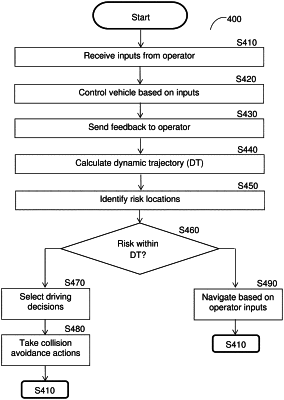| CPC B60W 30/09 (2013.01) [B60W 30/0953 (2013.01); B60W 30/0956 (2013.01); B60W 60/0054 (2020.02); G01C 21/32 (2013.01); G05D 1/0214 (2013.01)] | 15 Claims |

|
1. A method for collision avoidance, comprising:
calculating a dynamic trajectory of a vehicle, wherein the dynamic trajectory of the vehicle indicates a projected movement path of the vehicle;
creating a plurality of real-time dynamic maps based on sensor data collected by a plurality of sensors scanning an environment around the vehicle, wherein the plurality of real-time dynamic maps includes a plurality of risk locations, wherein each of the plurality of real-time dynamic maps is created for a distinct type of sensor among the plurality of sensors, wherein a respective real-time dynamic map of the plurality of real-time dynamic maps is created for each distinct type of sensor among the plurality of sensors; and
translating the dynamic trajectory of the vehicle to each of the plurality of real-time dynamic maps;
determining whether each of the plurality of risk locations is within the dynamic trajectory of the vehicle based on the translated dynamic trajectory and each real-time dynamic map, wherein each real-time dynamic map includes a subset of the plurality of risk locations determined based on sensor data for the respective distinct type of sensor for which the real-time dynamic map is created;
operating the vehicle based on a driving decision selected from among a first driving decision and a second driving decision when at least one risk location of the plurality of risk locations is within the dynamic trajectory of the vehicle, wherein the first driving decision is determined based on inputs by an operator of the vehicle, wherein the second driving decision is determined by a vehicle computing unit of the vehicle; and
operating the vehicle based on the inputs by the operator of the vehicle when no risk location is within the dynamic trajectory of the vehicle.
|